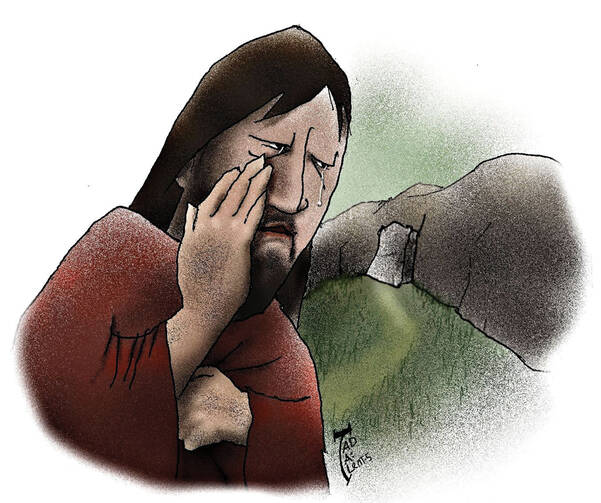Away With Death
Why did Jesus cry when he saw the tears of Lazarus’s sisters and his friends? After all, Jesus already knew Lazarus was dead. In fact, his purposeful actions allowed that death to occur. So why, when faced with the mourning of Lazarus’s loved ones, did Jesus cry? The account of the raising of Lazarus brings to the fore Jesus’ humanity and the reasons why Jesus came to conquer death.
Lazarus had two sisters, Mary and Martha, who “sent a message to Jesus” that their brother was ill. Jesus decides not to attend to his sick friend immediately, but to wait for two extra days, until Lazarus has died, and then go to “awaken” him from his “sleep.” Physical death, Jesus will demonstrate, is not the end of our lives, but a “sleep” from which we awaken through God’s power. In fact, Jesus has allowed this death to occur—he is “glad” he was not there—in order that the disciples “may believe.”
Jesus and his disciples travel to Lazarus’s home, where he has already been in the tomb for four days, but Martha intercepts them along the way. Martha says to Jesus, “Lord, if you had been here, my brother would not have died.” When Jesus responds, “Your brother will rise again,” she comprehends that Lazarus will rise up in the resurrection on the last day. Jesus affirms this as the bedrock of faith in him: “I am the resurrection and the life. Those who believe in me, even though they die, will live, and everyone who lives and believes in me will never die. Do you believe this?” And Martha declares her belief in Jesus.
She is soon joined by her sister, Mary, who comes out to meet them. A number of friends, who thought Mary was going to Lazarus’s tomb to cry, join her to console her. It is here that the story is grounded not just in the divine power of resurrection, but in the human heartache of death. Mary says to Jesus, “Lord, if you had been here, my brother would not have died.” This sentence Mary speaks in verse 32 is identical to the words of Martha in verse 21. But Mary begins to cry at Jesus’ feet when she speaks these words, unlike Martha, who consoled herself with the hope of resurrection.
When Jesus sees the weeping of Mary and her friends, he does not respond, “Your brother will rise again,” as he did with Martha. Instead, he becomes “greatly disturbed in spirit and deeply moved.” But why? He has caused this very scene, and was “glad” that Lazarus had died so that he could evoke faith in his disciples and perhaps others who knew Lazarus. Yet confronted by the searing loss that physical death brings, Jesus himself begins to cry. Again we ask why. He knows he can raise Lazarus from the dead; he knows that death will not have the final say over his life, or any other human life.
Yet at this time, in this moment, the human reality of death affects Jesus in a way it had never done before. In this encounter he does not simply know death in an abstract way but in the fabric of his human life, in his bones. He sees his friends mourn, even those who believe that death will one day be conquered; he feels the cold sting of a loved one laid in a tomb.
Ray Jasper, an inmate of death row in Texas who may be dead by the time this column appears, described empathy this way: “Empathy gives you an inside view. It doesn’t say, ‘If that was me’; empathy says, ‘That is me.’” Jesus cried because he felt our pain, shared our pain; he could say, “That is me.”
Jesus experiences the suffering of death as a human being, feels the loss shuddering through his friends. He knows the ravages death has wrought, returning us to the dust from which we have come. We remember during Lent that for our sake he would take on this same death in order to save us from death, for he saw the tears of others and cried tears of mourning. He did not have to die with us and die for us, but he wanted to wipe away our tears forever. He said: Away with death, for we were made for eternity.
This article also appeared in print, under the headline “Away With Death,” in the March 31, 2014, issue.








